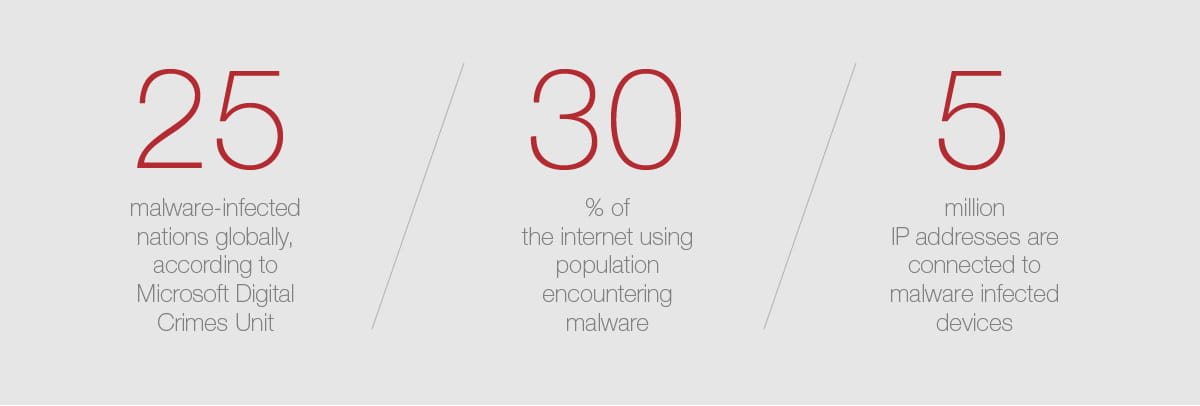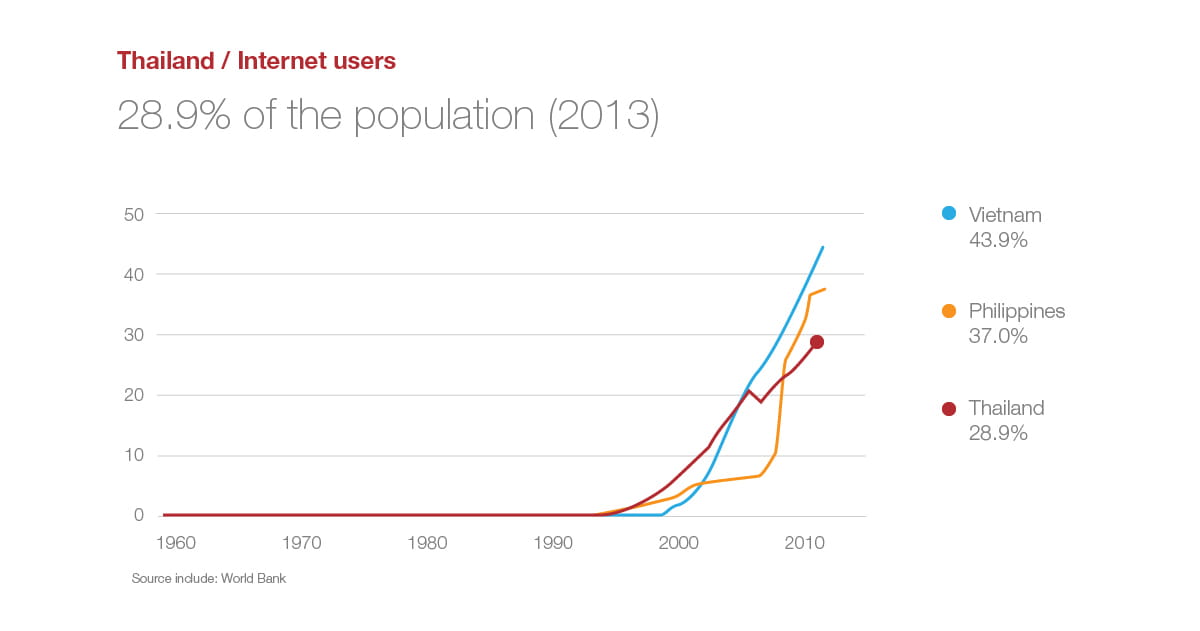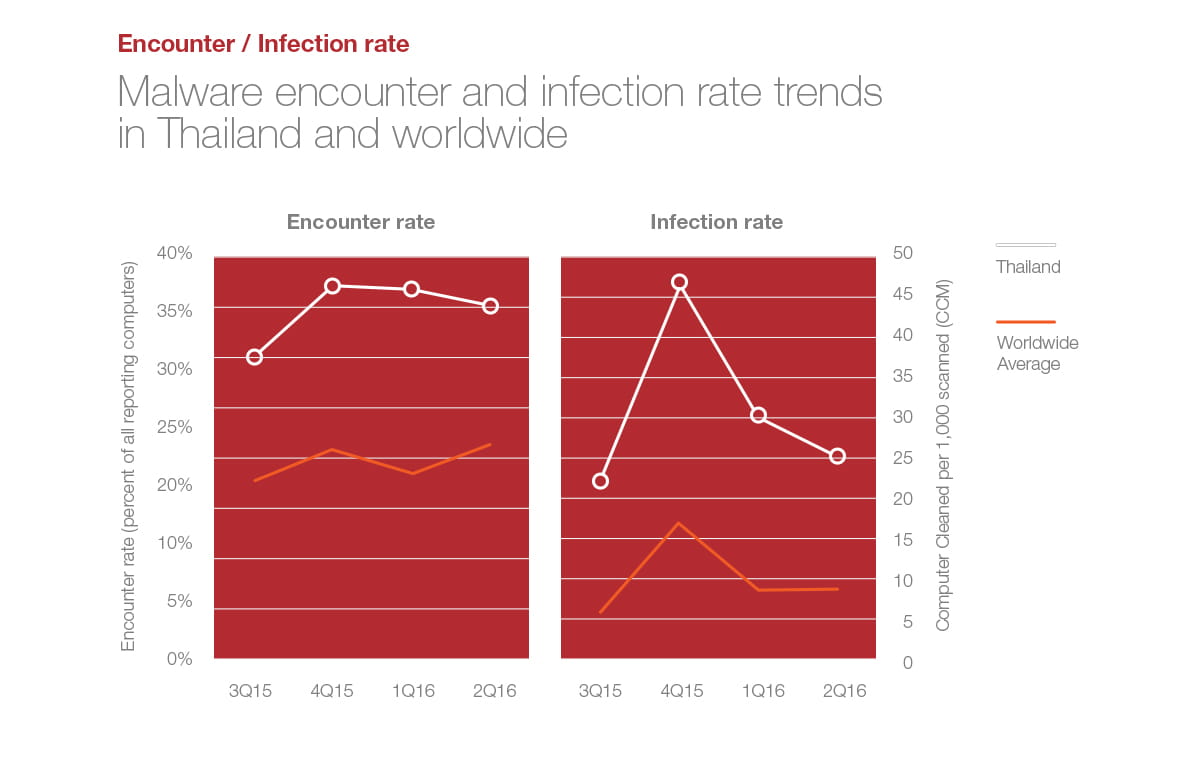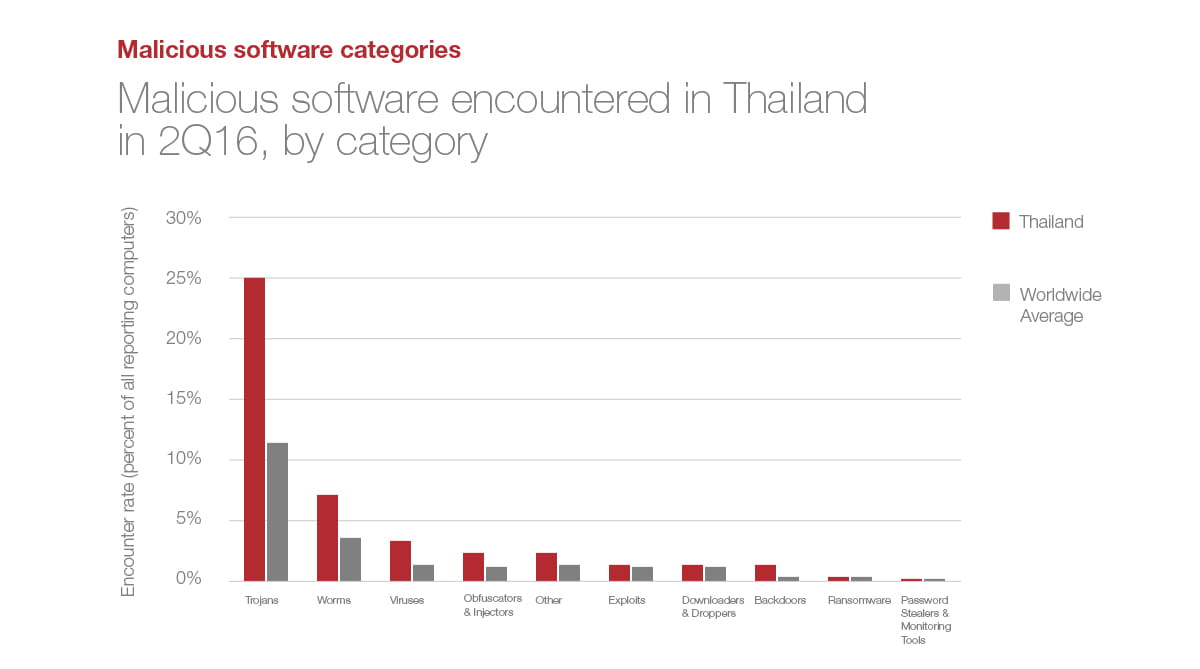Malware Rates in Thailand: Why You are at Risk.
Every year for the past two decades’ incidents of cybercrime have increased year-on-year worldwide. Recent studies expect this trend to continue, with cyber security costs set to double to $6 trillion by 2021. While most internet users are actually in Asia, virtually all research has been conducted on data collected exclusively from English-speaking countries.
Although Thailand is one of the fastest growing regions in the world in terms of internet usage; education on the pitfalls, prevention, protocols as well as out-date technologies leads to an increased risk of malware infection.
These issues leave Thailand among the top 25 malware-infected nations globally, per Microsoft Digital Crimes Unit. With around 30% of the internet using population in Thailand encountering malware, and an infection rate of 25%, over 5 million IP addresses are connected to malware infected devices.
A 2016 study BitDefender ranking SEA countries by exposure to ransomware, found Thailand to be in 5th place in Asia and 11th place globally. Thailand’s ranking was surpassed by a further four other countries in Asia – India, Indonesia, China and Vietnam.
Thailand also consistently ranks in the top ten countries for hosting phishing-based Trojans and downloaders and in the top 20 of countries where there is the greatest risk of infection (33%).
Why Thailand is at Risk
Lax security protocol in Thailand has not gone unnoticed by cyber-criminals. In 2015 Thailand became the world’s number 2 target for cybercrime, according to Allianz Global. Nearly 20% of Thailand’s cybercrime victims reported losses of over $100,000 USD and 4% reported losses of between $1 million and $100 million. 39% of SET-listed companies were victims of fraud in 2016, mostly perpetrated by external hackers and rogue employees.
Thailand’s internet usage is exploding, growing rapidly from 3.7% in 2000 to 30% in 2013 – recent studies indicate that it is now in excess of 60% and with 4G expansion this looks set to continue. As Thailand becomes more connected, organizations and individuals are going to become increasingly vulnerable to exploitation by cyber criminals looking to steal financial and confidential data.
Mobile proliferation is at 110% in Thailand with more phones than people. Malware that targets Android-based phones is expected to be on the rise with malware able to exploit vulnerabilities that plague android devices. Large corporate investment has laid the groundwork for online expansion in the region. This will lead to problems on eCommerce platforms which require mobile customers to increase and trust paying on eCommerce platforms.
Other problems link back to the high usage of counterfeit software in the region leaving individuals and businesses vulnerable to attack. For every ten computers in Thailand, eight are running counterfeit software of some variety according to Microsoft South East Asia. Furthermore, they studied software installed in Thailand, Indonesia, Malaysia, Philippines and Vietnam and found that 84% of hard drives tested in Thailand were infected with malicious software compared to 69% across the region.
All this malware comes as a price, The National University of Singapore found Asia-Pacific consumers would have lost $229 Billion because of infected pirated software and lost data. This expense accounted for about 45% of the global aggregate of 2014. Companies wasted 1.2 billion hours and $25 billion in spend dealing with issues arising from counterfeit programs.
Malware Rates in Thailand
Studies by Microsoft in the region indicated that 35% of computers in Thailand encountered malware of some variety over the second quarter of 2016 compared to a worldwide encounter rate of 21%. Infection rates are also high with Microsoft’s Malicious software tool removing malware from 25.3 from every 1000 unique computers scanned in Thailand compared to 16.9% worldwide. These figures only account for computers that are connected to Microsoft’s Malware removal tool, these users are tech savvy and risk averse.
Data from Microsoft Security Intelligence Report 2016
The most prevalent malicious software found on computers were Trojans, found on nearly 25% of infected computers. The second most common virus was worms, which were encountered more than 7.1% percent of all computers.
download.microsoft.com/…/Microsoft_Security_Intelligence_Report_Volume_21_Re… Cached
Lodback, which was encountered in 3.3% of reported computers is usually installed on removable drives and tries to install the malware when the removable drive is connected to new computers.
Gamarue was particularly prevalent in South East Asia and is the third more prevalent malware worldwide. Variants are usually distributed through exploit kits and social engineering.
ATM Malware: On August 1st to August 8th 2016, hackers attacked more than 21 ATMs belonging to the Thailand Government Savings Bank (GSB) and stole more than 12 million baht. Representatives of the bank cautioned that all attacked ATMs were made by NCR, and the attackers are likely to have used a bug or malware that compromised ATMs of the company.
Jasmine Begum, Director, Corporate External & Legal Affairs (CELA), Microsoft Malaysia said, “With increasing malware encounters and sophistication of cyberattacks, cybersecurity is becoming a mission critical priority for most organizations. It generally takes an average up to 200 days for organizations to find out that they have been breached. With no sign of abatement in the future, what companies need is a Secure Modern Enterprise posture, which involves well-integrated “Protect-Detect-Respond” investments and capabilities, with a strategic focus on the core pillars – Identity, Apps, Data, Infrastructure and Devices.
Additionally, organizations should also strongly consider adopting trusted cloud-based services to enjoy the highest levels of data protection, leveraging the cloud provider’s enterprise-grade security and privacy expertise, assurances and certifications.”
Beside ATM hacks, Thai consumers are exposed to greater cyber security risks while using mobile and internet banking service or doing e-commerce transactions online. The latest numbers indicate that Thailand has approached nearly 30 million internet bank accounts nationwide.
There is no sure-fire way to avoid malware on the internet as it’s so pervasive one can be infected by browsing the wrong sites or opening an email attachment. The best only way to combat ransomware is through the implementation of protocol that is adhered too and by educating yourself, or your employees about the risks.
 If you would like to speak about to experts in Thailand about how to tackle malware you can email Aware: info@aware.co.th
If you would like to speak about to experts in Thailand about how to tackle malware you can email Aware: info@aware.co.th
Written by Sean Allan, Digital Marketing Manager, //www.aware.co.th
Digital Marketing Manager at Aware Group: Working his way through the world of technology and Thailand as best as he can. Happy to contribute to other tech publications.




